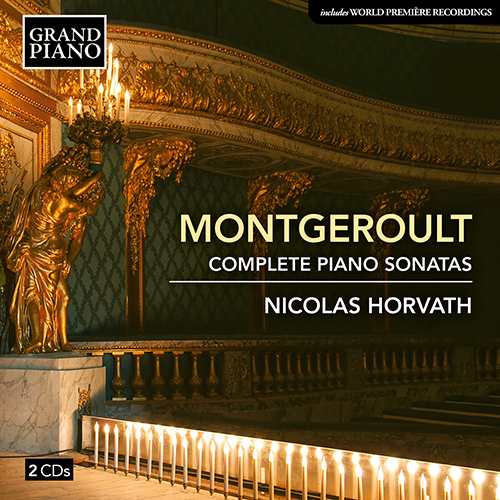
About this Release
“Collected here for the first time in one recording, the nine sonatas of the distinguished pianist, composer, and teacher Hélène de Montgeroult represent a major contribution to the rich French piano repertoire of the late Classic and early Romantic periods. She was influential in the development of the expressive cantabile style of the 19th century, not only as a performer and composer but also as the author of a celebrated piano method. She was a participant in regularly scheduled musical gatherings in the homes of wealthy music lovers, where she performed music with amateurs and internationally known professional musicians, French and foreign. Through the influential network of the musical and social elite her exceptional skills became widely known. The Revolution destroyed much of this world and Montgeroult herself was in mortal danger during the Terror as an aristocrat. Her life was saved by the founder of the Institut National de Musique (later the Conservatoire de Paris), who convinced the Revolutionary Tribunal that she was indispensable to the school as one of France’s greatest pianists. Many of the sonatas are world premiere recordings, and I hope you find these great visionary and virtuoso works as delightful as I did.” — Nicolas Horvath
MONTGEROULT, HÉLÈNE-ANTOINETTE-MARIE DE NERVO DE (1764–1836)
Complete Piano Sonatas
- Nicolas Horvath, piano
Hélène de Montgeroult was a student of Clementi in Paris. She survived the French Revolution – during which, as an aristocrat, her life was in grave danger – to become a celebrated pianist, composer and author of a famous piano method. Her compositional language in these nine sonatas is wide and includes Italianate models as well as elements that reflect the influence of Haydn and Mozart, with chromatic and surprising harmonies, contrasts of register, chorale-like nobility and brilliantly athletic finales. Featuring several world première recordings, these sonatas represent a major contribution to the French repertoire of the late Classical and early Romantic periods.
This recording was made on Steinway & Sons, Model D, No. 248200
Tracklist
|
Piano Sonata in F Major, Op. 1, No. 1 () (00:16:00 )
|
|
1
I. Allegro con spirito (00:04:29)
|
|
2
II. Prestissimo (00:05:12)
|
|
Piano Sonata in E-Flat Major, Op. 1, No. 2 () (00:15:00 )
|
|
3
I. Allegro con moto (00:08:29)
|
|
4
II. Allegro vivace (00:05:58)
|
|
Piano Sonata in F Minor, Op. 1, No. 3 () (00:19:00 )
|
|
5
I. Maëstoso con espressione (00:08:48)
|
|
6
II. Allegro agitato (00:10:35)
|
|
Piano Sonata in G Minor, Op. 2, No. 1 () (00:12:00 )
|
|
7
I. Allegro con moto e espressione (00:06:17)
|
|
8
II. Presto (00:05:48)
|
|
Piano Sonata in C Major, Op. 2, No. 2 () (00:20:00 )
|
|
9
I. Allegro moderato (00:09:24)
|
|
10
II. Andantino quasi allegretto (00:04:11)
|
|
11
III. Allegro con brio, vivace (00:06:01)
|
|
Piano Sonata in A Minor, Op. 2, No. 3 () (00:17:00 )
|
|
1
I. Agitato (00:06:48)
|
|
2
II. Adagio (00:07:19)
|
|
3
III. Vivace con espressione (00:02:53)
|
|
Piano Sonata in D Major, Op. 5, No. 1 () (00:26:00 )
|
|
4
I. Allegro spiritoso (00:13:47)
|
|
5
II. Adagio non troppo (00:05:17)
|
|
6
III. Allegro assai (00:01:17)
|
|
7
IV. Presto (00:05:34)
|
|
Piano Sonata in F Minor, Op. 5, No. 2 () (00:21:00 )
|
|
8
I. Allegro moderato con espressione (00:09:08)
|
|
9
II. Aria con espressione (00:05:04)
|
|
10
III. Allegro, agitato con fuoco (00:07:04)
|
|
Piano Sonata in F-Sharp Minor, Op. 5, No. 3 () (00:23:00 )
|
|
11
I. Allegro spiritoso (00:07:01)
|
|
12
II. Adagio non troppo (00:03:57)
|
|
13
III. Presto (00:05:25)
|
The Artist(s)
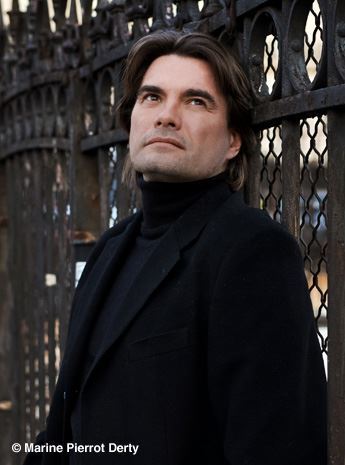 Nicolas Horvath began his music studies at Monaco’s Académie de Musique et de Théâtre Prince Rainier III and soon began to make an impression on a number of artists who would become his mentors. Aged 16 he caught the attention of the American conductor Lawrence Foster before coming to the notice of several distinguished international pianists, including Liszt specialist Leslie Howard. He is the recipient of numerous awards, including First Prize at both the Scriabin and the Luigi Nono International Competitions. He has become noted for hosting concerts of unusual length, sometimes lasting over twelve hours, such as the overnight performance of the complete piano music of Erik Satie at the Paris Philharmonie before a cumulative audience of 14,000 people. In 2019 he performed alongside Philip Glass at the same venue in a programme devoted to the American composer’s piano music. Horvath’s extensive and varied discography on Grand Piano includes the highly acclaimed Philip Glass solo piano music edition, Glassworlds; the complete piano works of Erik Satie; piano sonatas by the Estonian composer Jaan Rääts and music by the American experimental composer Alvin Lucier; Carl Czerny’s 30 Études; and lesser-known piano music by Claude Debussey, Anne-Louise Brillion de Jouy and Hélène de Montgeroult. Nicolas is a Steinway Artist.
Nicolas Horvath began his music studies at Monaco’s Académie de Musique et de Théâtre Prince Rainier III and soon began to make an impression on a number of artists who would become his mentors. Aged 16 he caught the attention of the American conductor Lawrence Foster before coming to the notice of several distinguished international pianists, including Liszt specialist Leslie Howard. He is the recipient of numerous awards, including First Prize at both the Scriabin and the Luigi Nono International Competitions. He has become noted for hosting concerts of unusual length, sometimes lasting over twelve hours, such as the overnight performance of the complete piano music of Erik Satie at the Paris Philharmonie before a cumulative audience of 14,000 people. In 2019 he performed alongside Philip Glass at the same venue in a programme devoted to the American composer’s piano music. Horvath’s extensive and varied discography on Grand Piano includes the highly acclaimed Philip Glass solo piano music edition, Glassworlds; the complete piano works of Erik Satie; piano sonatas by the Estonian composer Jaan Rääts and music by the American experimental composer Alvin Lucier; Carl Czerny’s 30 Études; and lesser-known piano music by Claude Debussey, Anne-Louise Brillion de Jouy and Hélène de Montgeroult. Nicolas is a Steinway Artist. The Composer(s)
 The nine sonatas of the distinguished pianist, composer, and teacher Hélène de Montgeroult represent a major contribution to the rich French piano repertoire of the late Classic and early Romantic periods. She was influential in the development of the expressive cantabile style of the 19th century, not only as a performer and composer but also as the author of a celebrated piano method.
The nine sonatas of the distinguished pianist, composer, and teacher Hélène de Montgeroult represent a major contribution to the rich French piano repertoire of the late Classic and early Romantic periods. She was influential in the development of the expressive cantabile style of the 19th century, not only as a performer and composer but also as the author of a celebrated piano method. Reviews
“[Horvath] has made another great recording of obscure repertoire like this current release… These are works that are well worth hearing, with superb playing, great recorded sound, and comprehensive booklet essays.” – American Record Guide

“Nicolas Horvath’s interpretation is impeccable in its clarity and brilliance” – Classica

“We (rediscover) a composer whose harmonic language and rhythmic vocabulary was constantly being reinvented… We would like to think that the marquise… would have appreciated Nicolas Horvath’s energetic and very expressive interpretation.” – Télérama
“This is music that is at times charming, at times “meaty” and direct, often full of overflowing notes, but it is very well constructed and intriguing, reminiscent of the music of her contemporary Muzio Clementi. We salute the (tireless) commitment of Nicolas Horvath for this more than interesting recording.” – Musique classique & Co

“This first complete recording with the sonatas of a highly imaginative and very individual composer is an important addition to the catalog of recordings of her works.” – Pizzicato
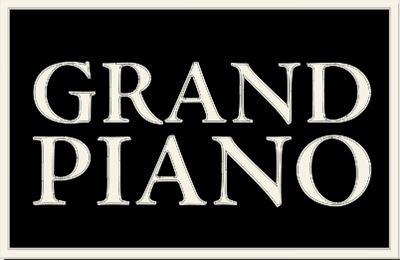
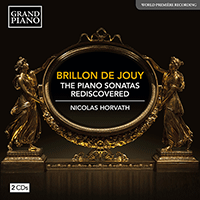

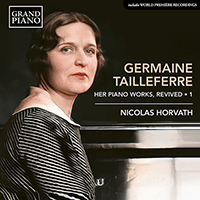

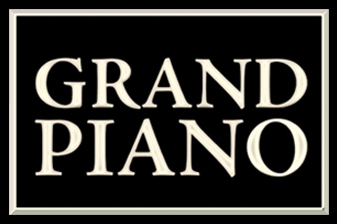 Grand Piano has gained a reputation for producing high quality recordings of rare keyboard gems. Dedicated to the exploration of undiscovered piano repertoire, the label specialises in complete cycles of piano works by many lesser-known composers, whose output might otherwise have remained unknown and unrecorded.
Grand Piano has gained a reputation for producing high quality recordings of rare keyboard gems. Dedicated to the exploration of undiscovered piano repertoire, the label specialises in complete cycles of piano works by many lesser-known composers, whose output might otherwise have remained unknown and unrecorded.






